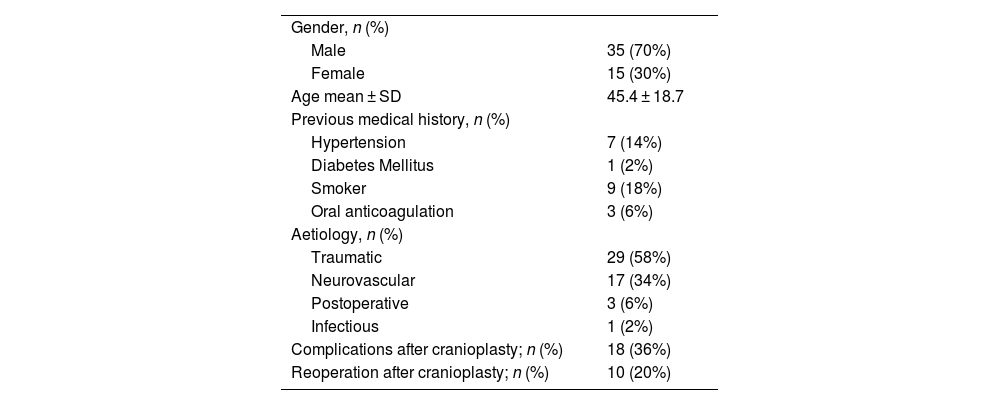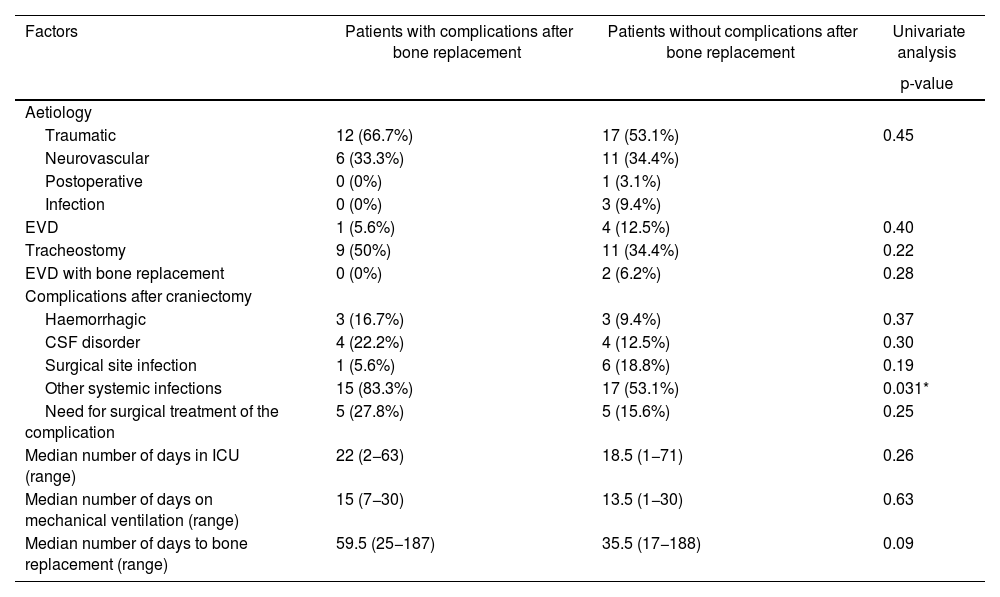Bone flap replacement after a decompressive craniectomy is a low complexity procedure, but with complications that can negatively impact the patient's outcome. A better knowledge of the risk factors for these complications could reduce their incidence.
Patients and methodsA retrospective review of a series of 50 patients who underwent bone replacement after decompressive craniectomy at a tertiary center over a 10-year period was performed. Those clinical variables related to complications after replacement were recorded and their risk factors were analyzed.
ResultsA total of 18 patients (36%) presented complications after bone flap replacement, of which 10 (55.5%) required a new surgery for their treatment. Most of the replacements (95%) were performed in the first 90 days after the craniectomy, with a tendency to present more complications compared to the subsequent period (37.8% vs 20%, p > 0.05). The most frequent complication was subdural hygroma, which appeared later than infection, the second most frequent complication. The need for ventricular drainage or tracheostomy and the mean time on mechanical ventilation, ICU admission, or waiting until bone replacement were greater in patients who presented post-replacement complications. Previous infections outside the nervous system or the surgical wound was the only risk factor for post-bone flap replacement complications (p = 0.031).
ConclusionsPostoperative complications were recorded in more than a third of the patients who underwent cranial bone flap replacement, and at least half of them required a new surgery. A specific protocol aimed at controlling previous infections could reduce the risk of complications and help establish the optimal time for cranial bone flap replacement.
La cirugía de reposición ósea tras una craniectomía descompresiva es un procedimiento a priori de baja complejidad, aunque no exento de complicaciones postoperatorias que pueden impactar negativamente en el pronóstico del paciente. Conocer aquellos factores que predisponen a dichas complicaciones podría reducir su incidencia.
Pacientes y métodosSe realizó una revisión retrospectiva de una serie de 50 pacientes sometidos a reposición ósea tras craniectomía descompresiva en un centro terciario a lo largo de 10 años. Se registraron aquellas variables clínicas relativas a las complicaciones agudas tras la reposición y se analizaron sus factores de riesgo.
ResultadosUn total de 18 pacientes (36%) presentaron complicaciones agudas tras la reposición ósea, de los cuales 10 (55,5%) requirieron una nueva cirugía para su tratamiento. El 95% de las reposiciones se realizaron en los primeros 90 días tras la craniectomía, con una tendencia a presentar más complicaciones respecto al periodo posterior (37,8% vs 20%, p > 0.05). La complicación más frecuente fue el higroma subdural, de aparición más tardía que la infección, que fue la segunda complicación más frecuente. Tanto la necesidad de drenaje ventricular o traqueostomía como el tiempo medio de ventilación mecánica, ingreso en UCI o espera hasta la reposición ósea fueron mayores en los pacientes que presentaron complicaciones post-reposición. La presencia previa de infecciones fuera del sitio quirúrgico fue el único factor de riesgo asociado al desarrollo de complicaciones post-reposición (p = 0,031).
ConclusionesEn la muestra analizada, se registraron complicaciones postoperatorias en más de un tercio de los pacientes a los que se les repuso el hueso craneal, y al menos la mitad requirieron una nueva intervención. Un protocolo específico dirigido al control de las infecciones previas podría reducir el riesgo de complicaciones y ayudar a establecer el tiempo óptimo para la reposición ósea craneal.
Article

If it is the first time you have accessed you can obtain your credentials by contacting Elsevier Spain in suscripciones@elsevier.com or by calling our Customer Service at902 88 87 40 if you are calling from Spain or at +34 932 418 800 (from 9 to 18h., GMT + 1) if you are calling outside of Spain.
If you already have your login data, please click here .
If you have forgotten your password you can you can recover it by clicking here and selecting the option ¿I have forgotten my password¿.











